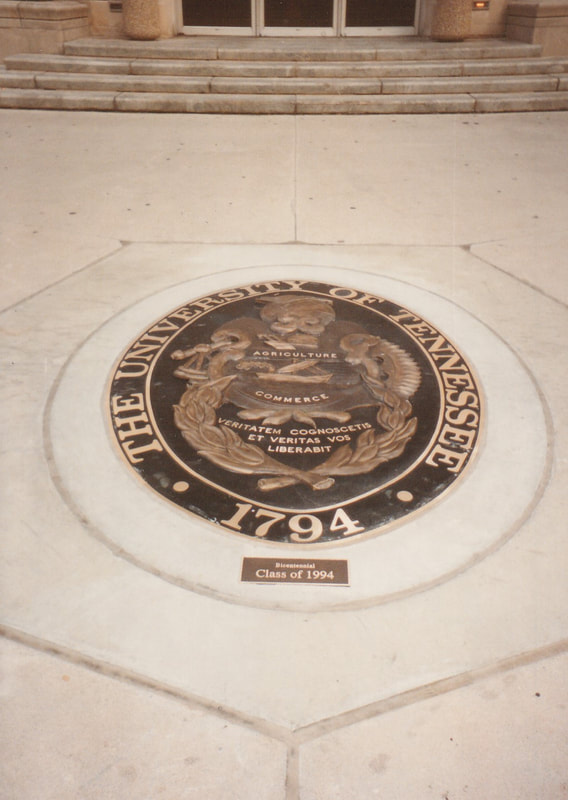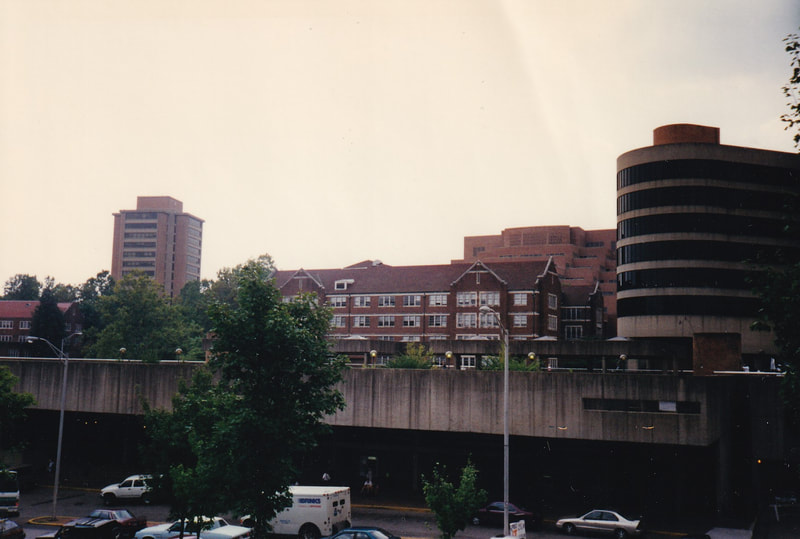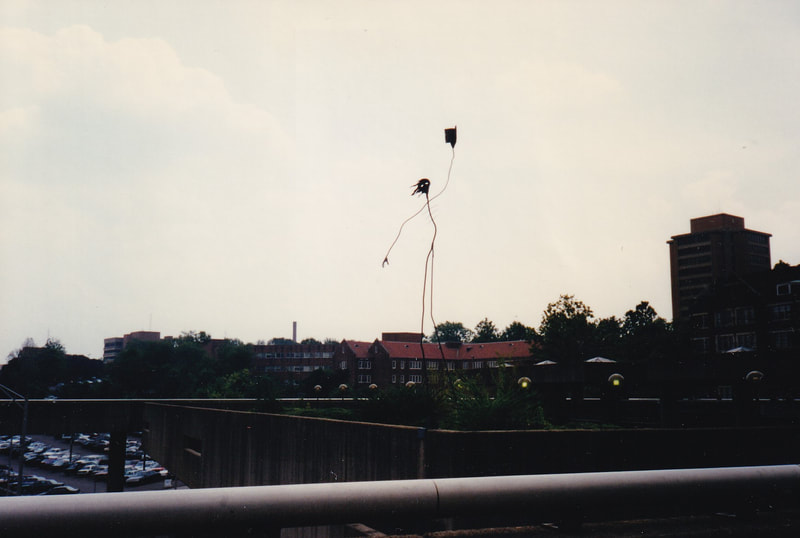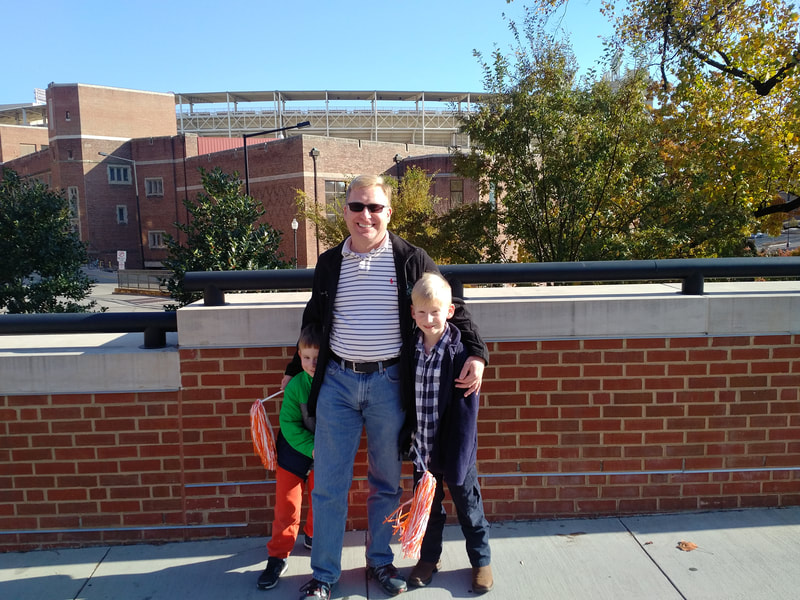University grounds
|
The Carolyn P. Brown University Center, or simply the UC, was the student union on the campus of the University of Tennessee when I arrived as a first year student in August 1988. It was a very nice student union despite the main body of it being over thirty years old at the time. It was the first university center on campus. Previously, an on-campus YMCA had served the purpose as a student union from 1890 to 1943. The YMCA would burn down that year and the campus would not have a replacement until 1947 when an old army surplus building took its place. Students had wanted a new facility even before the YMCA burned down, but no funds were available for the construction of anything non-essential. This would all change in 1947 when the university was contacted by a bank in New York. It appeared that the university might be due funds from the estate of John Scruggs Brown. He and wife Carolyn, a native of North Carolina, had purchased a home on Kingston Pike in Knoxville in 1906. An active member of the community, Carolyn had designed gardens for area schools and founded the Knoxville Garden Club. Brown had left a trust fund to his wife and her granddaughter in the 1920's. If the trust reached the sum of $25 million, the funds were to be used to create a girl's school in Knoxville. Upon the death of his wife (the granddaughter had passed away prior) the trust had not reached the $25 million mark. His will stipulated than in such a case the funds would go to UT to create a memorial to his wife. There was some wrangling over the money. Brown had ownership of properties in both Tennessee and North Carolina, and the heirs to these in both states wanted the trust funds. The granddaughter's widower also sought claim to the funds. In the end, the university received $1.5 million (worth about $17 million in 2021 money) and embarked on the creation of a new student union to be named in honor of Brown's wife. A detailed story appeared in the Knoxville Mercury in 2015 about Carolyn Brown, and it includes a photo of the buildings dedication plaque as well. You can read that story here. The building opened in 1954 and had some 105,000 square feet of space. Designed by the Knoxville architecture firm of Barber and McMurry, the building opened with only the dining facilities being air conditioned. Various modifications and renovations were undertaken over the years. The most notable of these included an air conditioning expansion throughout the building in 1958, a bowling alley added in 1959, and a large addition completed in 1967 which added over 107,000 square feet of space to the structure at an expense of $2,335,000 (or nearly $19 million in 2021 dollars). There was talk of a significant makeover and additions for many years with serious planning undertaken from 2007 to 2008. After determining the costs of remodeling and the scope of the desired addition, a decision was made to demolish the building and replace it. Initially, the plan was keep the Carolyn P. Brown moniker, but that was subsequently dropped (a loss in my eyes; no need to erase history along with the building). In a two-step process, the parking garage and plaza area behind the building would be demolished in 2012. After demolishing other structures on the same block, the remainder of the UC was subsequently razed. The new Student Union stands on the site today after more than five years of construction and a cost in the neighborhood of $170 million. The new structure, which I will detail later, is very nice. Still, I hated to see the old UC go. I spent a lot of time in that building and have great memories of it. The main floor (it was the second floor of the building but was the ground floor at the front of the structure) had a theater, multiple meeting rooms, a large meeting room/ballroom, several lounges, and a snack bar called the Sweet Shop. A large meeting room called the "Crest Room", was on that floor and it had the seals of the other southeastern schools around the entryway. I remember thinking at first that the seals were SEC schools, but noticed that the seals of the University of North Carolina and the University of South Carolina were there as well (South Carolina is a member of the SEC now, but was not back then). I cannot find any information online (or in books so far) as to how or why the schools which were represented were chosen. If you know, please leave a note in the comments. Later, a computer store would open in one of the lounge spaces on the first floor. The theater had a variety of events each year including speakers and movies. The Sweet Shop always seemed to be making popcorn, and the smell filled the lobby area. It also had bulk candy and a friend of mine was always buying chocolate covered peanuts which he happily shared with us. The third floor had lounges, some student services offices, and another large meeting/ballroom. At the top of the stairs in the front of the building was a lounge called the "Commuter Lounge". It had a variety of couches in it and was to be found filled with sleeping students most weekdays. The first floor contained two dining facilities, the ticket office, a post office, a food services administrative office, and the UT bookstore. I ran across a blog by Evan Kalish where he visits post offices around the country. He visited several universities in Tennessee which had post offices in student unions. You can read his post and see the inside of the UC here. The bookstore was in the east side of the building, and textbooks were in the basement floor. The textbook area was rather small, and I remember buying my books the first time there because it was so overwhelmed with students. It took hours to get your books and stand in line to pay. I remember being astounded by how much my books cost. In addition to books, I had to buy a fetal pig for dissection in my biology class and those were kept not with the textbooks but with the general supplies. The cafeteria was called called Smokey's Palace, named after the mascot Smokey (a blue tick hound dog). I believe it was a faculty cafeteria when the building opened and at one point was called "The Lantern Room". During my time there, it served the same food as every other cafeteria on campus. Back then, the food services at UT was notably poor. I was once served a sandwich with very moldy bread there. I took it back and they didn't want to refund my money! I looked closer when I went back in and all of the sandwiches had moldy bread! The other dining spot was Rafters. It made sandwiches to order and other quick foods. The basement had a recreation area called "Down Under" which during my time had pool tables, video games, an old fashioned large screen projection TV, and a bowling alley. The bowling alley was called the "William B. Stokely Memorial Bowling Center". This was separate from the basement area of the bookstore. Alumnus William B. Stokely Jr. (class of 1922) donated stock from the Stokely-Van Kamp company valued at about $11k to create the alley. Along with the revenue from lane fees, this covered the expense of installing it. It was named in honor of his father, William B. Stokely Sr., an 1895 alumnus who was captain of the first UT football team, member of the Board of Trustees, and a donor to the university. Behind the building was a parking garage, the top of which had two sets of walkways allowing access across the area and over Stadium Drive (now Phillip Fulmer Way) and on to The Hill. The top of the parking garage was a spilt plaza with seating areas. Many activities were held there. On the lower level of the garage facing Stadium Drive was a collection of ATM's affectionately called "the Money Wall". There was also a bus stop area there. The parking garage was built on the site of a parking lot. The garage was designed in-house by then Dean of the School of Architecture Robert Church. It opened in 1971 and had a budget of $1.67 million (or about $11.5 million today). The first photo below, taken in July 1996, is the front (Cumberland Avenue Side) of the building. You can see the University Seal, a gift of the class of 1994, in front of the entrance. In the windows on the right of the photo you can see the stairs in the main stairwell. There was a large chandelier hanging in that stairwell which was made possible by a $1,000 donation by the Omicron Delta Kappa Honor Society. The second photo is a close up of the seal taken two years earlier on June 21, 1994. Since the structure was razed, I am uncertain what became of the seal. Hopefully, it was reused on the site or somewhere else on campus. I have not looked for it on campus, but it is not visible on the satellite images of Bing and Google online. If you know, please make a note in the comments. The third photo is a view from the west side pedestrian bridge looking back toward the UC plaza/parking garage. It is a bit dark, but behind the armored truck is the Money Wall. The building in the center of the photo is the Glocker Business Administration Building. The photo is from August 1997. I happened to be visiting Knoxville with my then significant other and now wife in 2005 when they were ripping Glocker apart to create the new/current James A. Haslam II Business Building. The area was fenced off and there were random bricks all over the site. One was near the sidewalk and I pulled up the fence and took it as a momento. It sits in my home office on a shelf along with a piece of the original astroturf used in Neyland Stadium. To the right of Glocker is the Stokely Management Center, commonly called the "Spam Can" for its resemblance to that iconic tin. Just behind Glocker is the John C. Hodges Library. It is a magnificent structure and I will do a post on it later for this blog. To the left is McClung Tower, part of the Humanities and Social Sciences Complex. I will do a post on each of these buildings later as well. The fourth and fifth photos are of a sculpture that once stood on the side of the top of the parking garage behind the UC. I took the first photo during a visit to campus in May 1997, and the second later that year in August 1997. I've looked online to see if I could find out the name and the artist who created it but I haven't been able to determine anything definitive. I believe it was part of the UT Outdoor Sculpture Tour which started in 1982. If this is the case, it was likely taken down a few years later when the tour was discontinued. If you know anything about it, please leave a comment. The sixth photo is of one of two framed editorial cartoons that once graced the walls of the Commuter Lounge on the top floor of the UC. I took this during a visit to campus in August 1997. I had a photo of the one above it, but it and the negative have been lost. This particular one commemorates President Lyndon Johnson's visit to Knoxville and UT on May 7, 1964. Johnson was touring Appalachia to promote his "War on Poverty" in rural southern communities. As his motorcade passed campus, he was taken by the size of the crowd by the UC and had the car stopped so he could say a few words. UT President Andy Holt welcomed him to campus. He gave a short speech and encouraged people to help fight poverty. My favorite part of the picture is the quote of Mrs. Johnson "I go for U-T's!". I hope these were saved and are hanging in the new Student Union somewhere. You can read more about LBJ's visit here. The seventh photo is of the sculpture "Terra" by Julie Warren Martin taken in December 1996. Martin is a 1965 alumnae of the university with a degree in Fine Arts. The piece is pink limestone set on a twelve foot circular base of granite. It was commissioned for the university's 200th anniversary and was installed on December 7, 1994 on the UC grounds in front near Cumberland Avenue. It sits outside the current Student Union near the corner of Cumberland and Volunteer Boulevard. The eighth photo is of yours truly. I was inducted into an honor society in the UC on a warm March, 1994 Saturday. I had parked near Austin Peay on The Hill and was on my way back there when this photo was taken. You can see the book-holding figure seen in the fourth photo behind and to the right of me. Just behind me is the Turner House. The Turner House was subsequently demolished and replaced by the Burchfiel Geography Building. Behind Turner, you can see the Hesler Biology Building and to the left of me is the Austin Peay Building. I will have a post on all of the buildings on the Hill soon and will delve into the various histories of each. The last three photos are of my two sons and I on the new pedestrian bridge in nearly the same place I was standing on the old walkway in the previous photo. My sons loved the pom poms available at athletic events when they were younger (they have some from UofM basketball games as well) and when visiting the new bookstore they saw these and had to have them. The last two photos of are them along the walkway. All three photos were taken during a visit on a sunny and warm day in November 2017. If you are interested in the history of the university, I would recommend the book To Foster Knowledge: A History of the University of Tennessee, 1794-1970 by James R. Montgomery, Lee S. Greene, Stanley J. Folmsbee, and Lee Seifert Greene. I have read many books on the history of different universities and this is a well written and thorough piece. I first came across the book while wandering the stacks in Hodges Library. It was the first book on the history of a university I ever read; I’ve read it several times since and there is a copy on my bookshelf in my home office. It is a very good read. Other good histories of the university include The Volunteer State Forges its University: The University of Tennessee, 1887-1919 by James Riley Montgomery, and the photobook Tennessee: A Celebration of 200 Years of the University by Betsey B. Creekmore.
3 Comments
Kenan Smith
10/20/2022 02:00:53 am
I much enjoyed this article. Jogging my memory of a special place.
Reply
Ann Ward
10/28/2022 07:38:14 am
My most vivid memory of the Student Center (as we called it in the early ‘70’s) was sitting with male friends waiting to hear when their draft number was determined in the birthday lottery. Not a happy memory. But I agree that it is sad the names of buildings are being lost as new ones are erected. Next in line are Dunford, Greve and Hesler. The names were given for a reason and it’s sad to forget these individuals.
Reply
Scott Sanders
3/17/2023 12:14:59 pm
I happened across this page somehow, while looking for information about the new Nursing building. I was recently wondering on a Facebook page what happens to old building names. There should be a wall of lost names somewhere. Sad. (1989 grad)
Reply
Your comment will be posted after it is approved.
Leave a Reply. |
AboutUniversity Grounds is a blog about college and university campuses, their buildings and grounds, and the people who live and work on them. Archives
February 2024
Australia
Victoria University of Melbourne Great Britain Glasgow College of Art University of Glasgow United States Alabama University of Alabama in Huntsville Arkansas Arkansas State University Mid-South California California State University, Fresno University of California, Irvine (1999) Colorado Illiff School of Theology University of Denver Indiana Indiana U Southeast Graduate Center Mississippi Blue Mountain College Millsaps College Mississippi Industrial College Mississippi State University Mississippi University for Women Northwest Mississippi CC Rust College University of Mississippi U of Mississippi Medical Center Missouri Barnes Jewish College Goldfarb SON Saint Louis University Montana Montana State University North Carolina NC State University Bell Tower University of North Carolina Chapel Hill Tennessee Baptist Health Sciences University College of Oak Ridge Freed-Hardeman University Jackson State Community College Lane College Memphis College of Art Rhodes College Southern College of Optometry Southwest Tennessee CC Union Ave Southwest Tennessee CC Macon Cove Union University University of Memphis University of Memphis Park Ave University of Memphis, Lambuth University of Tennessee HSC University of West Tennessee Texas Texas Tech University UTSA Downtown Utah University of Utah Westminster College Virginia Virginia Tech |












